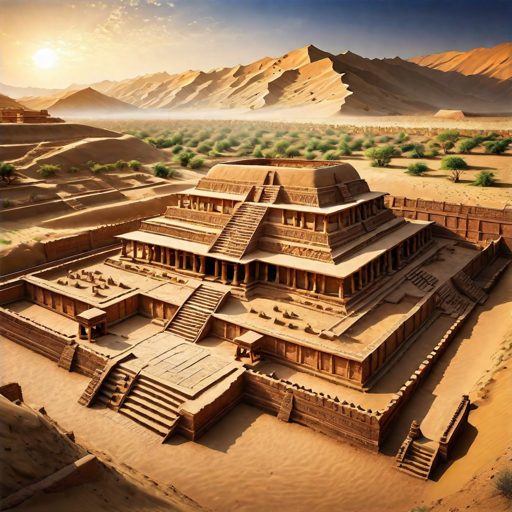
Indus Civilisation: An Unexplained Disappearance
Ladies and gentlemen, gather around as we delve into the enigmatic world of the Indus Civilisation, a tale that takes us back to the dawn of urban society, where the mysteries are as captivating as the truths unearthed. So, let’s embark on this journey through time, unraveling the story of one of history’s greatest civilizations.
History & Discovery
Imagine, if you will, the sheer wonder of Charles Masson, an English explorer with an insatiable thirst for the unknown. In 1826, amidst the dust of the Punjab region, he stumbled upon the ruins of Harappa, cracking open the door to a civilization that flourished between 2600 BCE and 1900 BCE. This wasn’t just a discovery; it was the unveiling of a society that had mastered the art of living.
Harappa, alongside Mohen-jo-Daro, stood as a beacon of the Indus Civilisation, with its meticulously planned streets and sophisticated urban planning. It’s staggering to think that over 1,000 sites related to this civilization have been uncovered across present-day Pakistan, India, Afghanistan, and Iran. The civilization’s name, derived from the Indus River, hints at the life-giving force that nurtured this society’s growth.
The ruins of Harappa revealed a city that knew the value of structure and community living. Massive fortifications protected its public buildings and private houses, while the streets were laid out in a grid pattern that would make any modern city planner proud.
This civilization wasn’t just surviving; it was thriving, with advanced systems of governance and a sophisticated trading system, underscored by standardized weights and measures. Yet, despite these advancements, the Indus script remains a puzzle, a cryptic message from the past that continues to elude full decipherment.
Civilization & Culture
Now, let’s dive deeper into the heart of the Indus Civilisation’s daily life and culture. Picture cities built with precision, where baked bricks laid the foundation for structures that have stood the test of time. The Great Bath in Mohen-jo-Daro, a significant architectural feat, suggests a society that placed a high value on cleanliness and perhaps ritual purification.
The spiritual life of the Indus people was rich and varied, practicing a blend of early Hinduism, Jainism, and Buddhism. This diversity in belief systems indicates a complex societal structure where religion played a central role. The artistic legacy of the Indus Civilisation, captured in carvings of animals, humans, and gods, paints a picture of a society deeply connected to its surroundings and beliefs.
Language and communication were pivotal, with the proto-Dravidian language believed to be the tongue of the Indus people. Their development of one of the world’s first conversion systems showcases their advanced understanding of mathematics and measurement.
Despite the absence of a hierarchical structure, the society was highly organized, as evidenced by their granaries, storage facilities, and sophisticated drainage systems, marking them as a civilization far ahead of its time.
Decline & Legacy
As all great narratives do, the story of the Indus Civilisation draws to a close around 1900 BCE, with its eventual disappearance by 1300 BCE. The reasons for this decline are as varied as they are speculative, ranging from climate change to political instability. Yet, remarkably, there is no evidence of war or conflict, suggesting a society that may have faded as peacefully as it lived.
What remains of the Indus Civilisation is a legacy of advanced urban planning, a testament to human ingenuity and the capacity for societal harmony. Their script, largely unreadable to this day, holds secrets of a past ripe for discovery, offering lessons in diplomacy, cooperation, and the importance of adaptation and innovation.
In conclusion, the Indus Civilisation stands as a beacon from the past, reminding us of the complexities of human history and the enduring spirit of discovery that drives us forward.
As we continue to explore and understand this ancient society, we not only uncover the mysteries of the Indus people but also reflect on our own place in the tapestry of time. Truly, the Indus Civilisation is a chapter in human history that remains as fascinating as it is instructive.
Related Stories
- Unsolved Mysteries of Indian History
- India Jaisalmer: Kuldhara’s Quietly Haunting!
- Kerala Tourist Places: Kodinhi’s Twin Enigma
Curious Times is a leading newspaper and website for kids. We publish daily global news aligned to your learning levels (also as per NEP 2020): Foundational, Preparatory (Primary), Middle and Senior. So, check out the News tab for this. We bring kids’ favourite Curious Times Weekly newspaper every weekend with top news, feature stories and kids’ contributions. Check out daily JokesPoke, Tongue Twisters, Word of the Day and Quote of the Day, kids need it all the time.
ME – My Expressions at Curious Times is your place to get your work published, building your quality digital footprint. And it is a good way to share your talent and skills with your friends, family, school, teachers and the world. Thus, as you will step into higher educational institutes your published content will showcase your strength.
Events, Quizzes and Competitions bring students from over 5,000 schools globally to participate in the 21st-Century themes. Here schools and students win certificates, prizes and recognition through these global events.
Sign-up for your school for FREE!
Communicate with us: WhatsApp, Instagram, Facebook, Youtube, Twitter, and LinkedIn.
0 (Please login to give a Curious Clap to your friend.)
SignUp to Participate Now! Win Certifiates and Prizes.

[…] Indus Civilisation: An Unexplained Disappearance […]
[…] Indus Civilisation: An Unexplained Disappearance […]
[…] Indus Civilisation: An Unexplained Disappearance […]